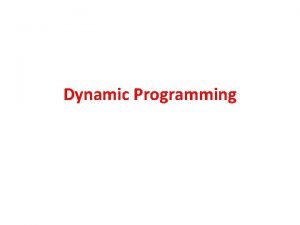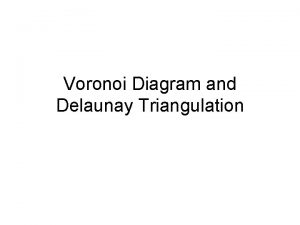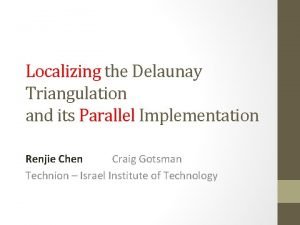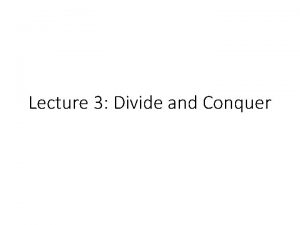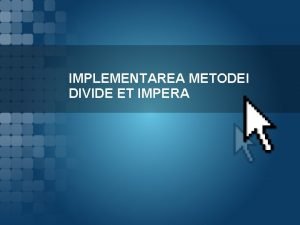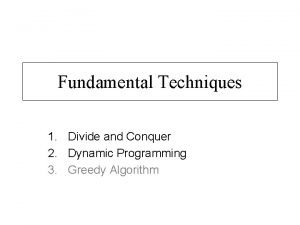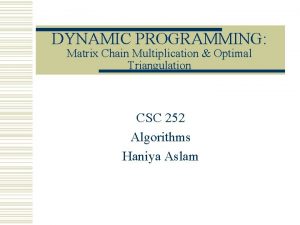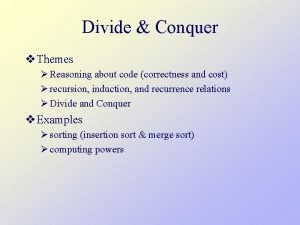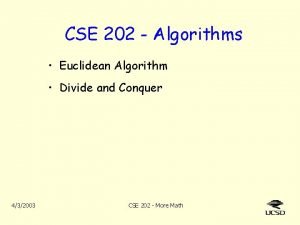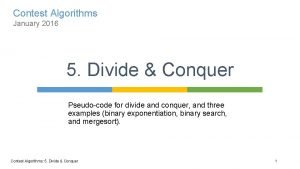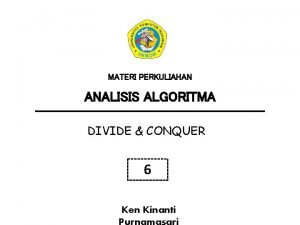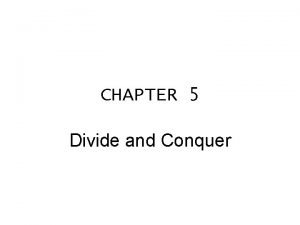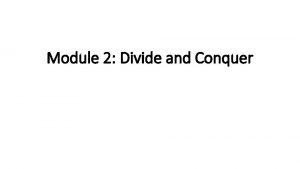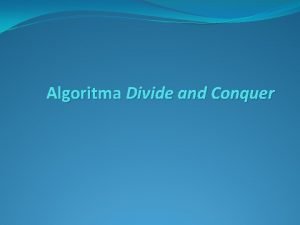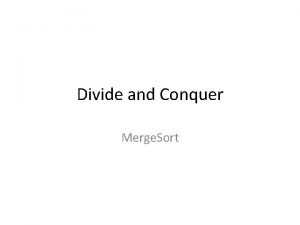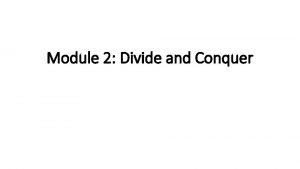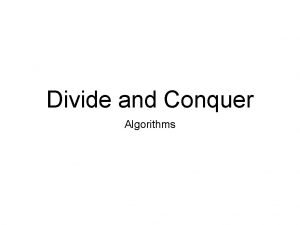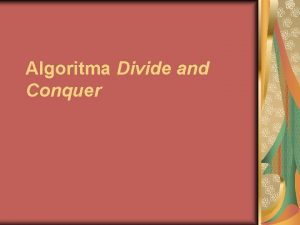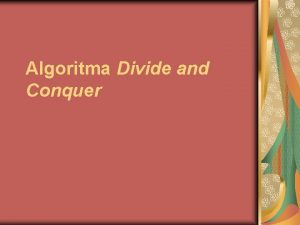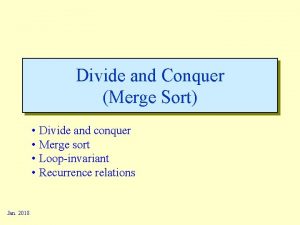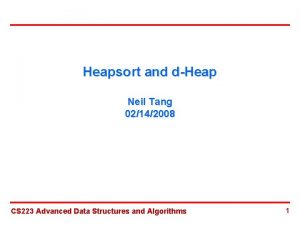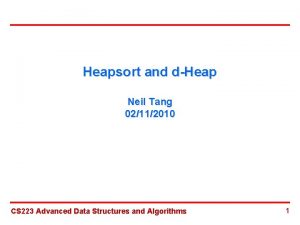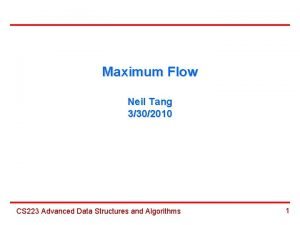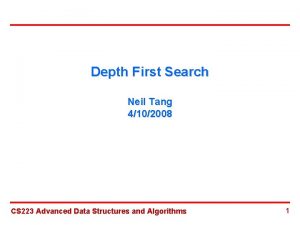Divide and Conquer Neil Tang 4152010 CS 223


















- Slides: 18

Divide and Conquer Neil Tang 4/15/2010 CS 223 Advanced Data Structures and Algorithms 1

Class Overview Ø Basic idea Ø Quick sort Ø Merge sort Ø Integer multiplication Ø Matrix multiplication CS 223 Advanced Data Structures and Algorithms 2

Basic Idea Ø Divide: divide the original problem to several sub-problems. Ø Conquer: Solve the sub-problems recursively. Ø Combine: Combine the solutions to sub-problems to form a solution for the original problem. CS 223 Advanced Data Structures and Algorithms 3

Merge Sort Ø Divide: Divide the N-element sequence into 2 subsequences of N/2 each. Ø Conquer: Sort each subsequence recursively using merge sort. Ø Combine: Merge two sorted subsequences to produce a single sorted sequence. CS 223 Advanced Data Structures and Algorithms 4

Merge Sort CS 223 Advanced Data Structures and Algorithms 5

Merge Sort Ø T(N) = 2 T(N/2) + N Ø a=2, b=2, f(N)=N Ø log 22 = 1 Ø So we have case 2, T(N) = (Nlog. N). CS 223 Advanced Data Structures and Algorithms 6

Quick Sort Ø Divide: Divide the sequence into 2 subsequences, s. t. each element in the 1 st subsequence is less than or equal to each element in the 2 nd subsequence. Ø Conquer: Sort each subsequence recursively using quick sort. Ø Combine: no work is needed. CS 223 Advanced Data Structures and Algorithms 7

Quick Sort people age 25 people age < 23 age people 23 age 25 people age < 30 30 CS 223 Advanced Data Structures and Algorithms people age 30 8

Quick Sort Ø T(N) = T(N-1) + N Ø The Master method does not work. Ø T(N) = O(N 2) CS 223 Advanced Data Structures and Algorithms 9

Integer Multiplication Ø Compute XY, where X and Y are N-digit integers. Ø Divide: X=XL 104+XR , Y=YL 104+YR Ø Conquer and combine: XY = XLYL 108 + (XLYR+ XRYL)104+XRYR CS 223 Advanced Data Structures and Algorithms 10

Integer Multiplication Ø T(N) = 4 T(N/2) + (N) Ø a=4, b=2, f(N)= (N) Ø log 24 = 2 Ø So we have case 1, T(N) = (N 2). CS 223 Advanced Data Structures and Algorithms 11

A Better Algorithm CS 223 Advanced Data Structures and Algorithms 12

Integer Multiplication Ø T(N) = 3 T(N/2) + (N) Ø a=3, b=2, f(N)= (N) Ø log 23 = 1. 59 Ø So we have case 1, T(N) = (N 1. 59). CS 223 Advanced Data Structures and Algorithms 13

Matrix Multiplication Ø Compute AB, where A and B are N N matrix. Ø Divide: Divide each matrix to 4 quadrants. Ø Conquer and combine: CS 223 Advanced Data Structures and Algorithms 14

Matrix Multiplication CS 223 Advanced Data Structures and Algorithms 15

Matrix Multiplication Ø T(N) = 8 T(N/2) + (N 2) Ø a=8, b=2, f(N)= (N 2) Ø log 28 = 3 Ø So we have case 1, T(N) = (N 3). CS 223 Advanced Data Structures and Algorithms 16

A Better Algorithm CS 223 Advanced Data Structures and Algorithms 17

Matrix Multiplication Ø T(N) = 7 T(N/2) + (N 2) Ø a=7, b=2, f(N)= (N 2) Ø log 27 = 2. 81 Ø So we have case 1, T(N) = (N 2. 81). CS 223 Advanced Data Structures and Algorithms 18
 Tang song menu
Tang song menu Divide and conquer advantages and disadvantages
Divide and conquer advantages and disadvantages Top down greedy approach
Top down greedy approach Delaunay triangulation divide and conquer algorithm
Delaunay triangulation divide and conquer algorithm Delaunay triangulation divide and conquer algorithm
Delaunay triangulation divide and conquer algorithm Counting inversions divide and conquer
Counting inversions divide and conquer Probleme divide et impera
Probleme divide et impera Divide and conquer
Divide and conquer Dynamic programming vs divide and conquer
Dynamic programming vs divide and conquer Divide and conquer
Divide and conquer Gambar penggunaan divide and conquer
Gambar penggunaan divide and conquer The skyline problem using divide and conquer algorithm
The skyline problem using divide and conquer algorithm Is euclidean algorithm divide and conquer
Is euclidean algorithm divide and conquer Divide and conquer pseudocode
Divide and conquer pseudocode Divide and conquer recurrence relation
Divide and conquer recurrence relation Tuliskan algoritma divide and conquer
Tuliskan algoritma divide and conquer Divide should ideas prevail
Divide should ideas prevail Divide and conquer algorithm
Divide and conquer algorithm Divide and conquer algoritma
Divide and conquer algoritma


